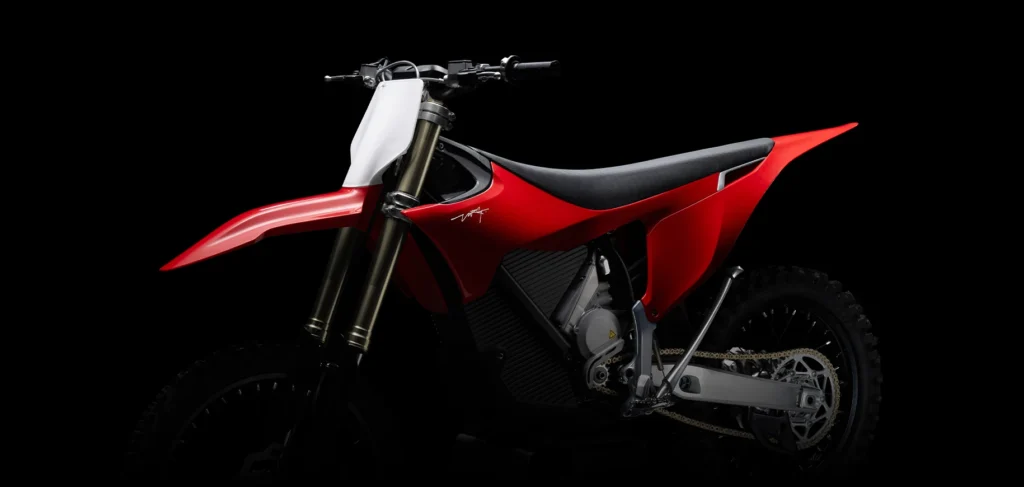Farsoon and Stark Future have taken a big step in their partnership. The two companies are already doing serial production of functional parts for Stark’s electric motorbikes. However, their new KLINGA Project was not designed to make bike parts. Instead, it was a test project to push the limits of Farsoon’s titanium printing process and prove their laser powder bed fusion (LPBF) machines can mass-produce complex, sharp-angled titanium parts with repeatable quality.
In this case, the KLINGA Project produced over 1,000 titanium parts using Farsoon’s industrial metal 3D printers. The centerpiece is the KLINGA Sabre, a tall engineering sculpture inspired by Stark’s electric motocross bike, the VARG. More than 60 cm high, this sculpture has sharp edges, complex shapes, and even a working titanium bottle opener shaped like a moose head. It was built to show what modern metal 3D printing can do.
Full build plate of KLINGA Sabres. Image courtesy of Farsoon.
The VARG is the flagship product that defines Stark Future’s place in the electric motocross market. Stark Future is a Barcelona-based company that designs and builds electric motocross bikes. They launched their first production model, the Stark VARG, in 2021, and it has become known for being powerful, agile, and emission-free, making it a strong rival to traditional 450 cc gas bikes. Stark Future has rapidly expanded its reach, distributing the VARG in over 50 countries, and is even preparing street-legal models for broader markets.
Engineer during the production of Stark FutuFuture’sg motorbike. Image courtesy of Stark Future via LinkedIn.
While the VARG set the standard for Stark Future’s performance and design, the KLINGA Project was created to see how far Farsoon’s 3D printing could go in reaching that same level.
In fact, the KLINGA Project tested every step of titanium 3D printing, including: creating special print settings for titanium, designing parts for 3D printing (DfAM), reducing supports to save time and material, using adaptive layer thickness for different heights, proving they could print the same parts over and over again with consistent quality, post-processing, and checking part quality.
The KLINGA Sabre. Image courtesy of Farsoon.
The sabres were made on Farsoon’s FS811M machine, a large-format LPBF system. This model has 12 lasers and a huge build size of 840 mm x 840 mm x 960 mm, or up to 1,700 mm tall in z-height. It is ideal for producing large, complex metal parts, such as aerospace structures, energy components, automotive tooling, and high-end industrial prototypes.
In one large print job lasting 248 hours (just over 10 days), the FS811M made 188 sabres at an average of under 80 minutes each. Farsoon says the same high quality can also be achieved on another of its LPBF printers, the FS721M, which Stark Future already uses.
The FS811M-12. Image courtesy of Farsoon.
Farsoon’s printers are known for making complex, sharp-angled titanium parts with repeatable results. Lately, Farsoon machines have been making headlines for large-scale, high-precision production in both metals and plastics. The company recently crossed a milestone of 150 “meter‑scale” metal 3D printers sold around the globe, with clients in North America, Europe, and Asia‑Pacific. One of its most high-profile users is major parts supplier Falcontech, which has installed nearly 40 of Farsoon’s meter‑scale systems since 2019 to manufacture end-use parts, especially large titanium structural components and copper alloy thermal systems.
For Stark Future, this project shows that 3D printing can be used for real production: “The KLINGA Project was a bold way for us to push boundaries — not just in design, but in manufacturing,” says Benjamin Cobb, Director Brand Communications at Stark Future. “Partnering with Farsoon allowed us to turn an ambitious idea into a titanium reality. It’s proof that large-scale, high-precision metal additive manufacturing is ready for serial production. It also validated our belief that 3D printing can deliver performance, quality, and sustainability—all at once.”
KLINGA Sabres under part breakout process in an FS811M Machine. Image courtesy of Farsoon.
For Farsoon, it’s proof that their machines can deliver precision, repeatability, and cost efficiency at scale. Stark Future isn’t the only company using 3D printing for electric bikes. Energica, which makes high-performance electric motorcycles, uses the technology for dashboards, headlights, drivetrain protection parts, cooling components, and other functional pieces. Other companies are also exploring 3D printing in different ways. Engrich ART Motorcycle uses it for parts like the main air box body, air intake, and rear seat cowl on its luxury models. DAB Motors, a French brand making 100% electric, customizable motorcycles, prints certain components to support its design-focused builds.
Meanwhile, GT Moto uses 3D printing to prototype and produce final parts for custom motorcycles, and 3D printing company Pantheon even built a complete motorcycle in a week using reinforced polymers as part of a challenge. Partnerships like WASP and Honda are also testing how additive manufacturing can reshape motorcycle design and production. All of these use cases show that 3D printing is becoming a practical tool for motorcycle makers around the world.
“We’re already mass producing 3D printed titanium parts — right here in our factory, just meters from where the bikes are assembled,” says Anton Wass, CEO of Stark Future. “3D printing titanium at scale means lighter, stronger, more complex components—with zero material waste. What’s usually reserved for aerospace or Formula 1? We’re building into every bike.”
